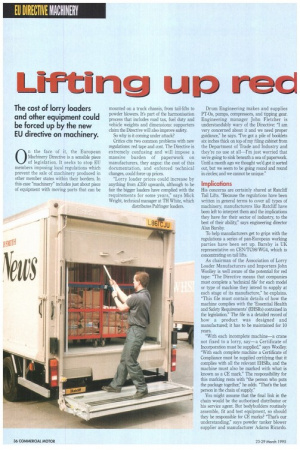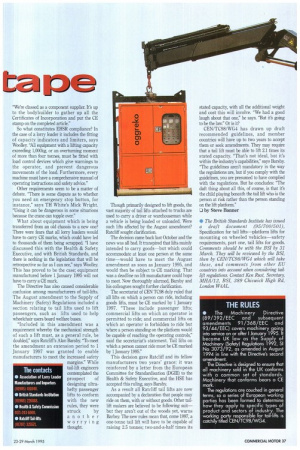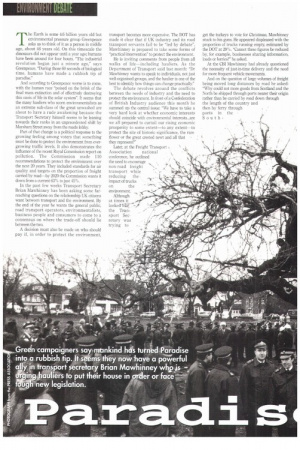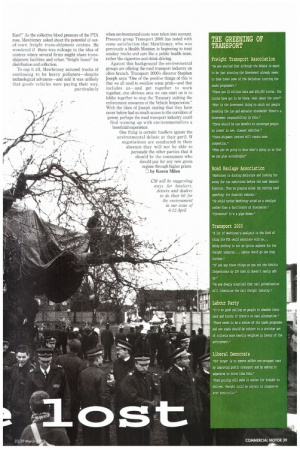Lifting up red
Page 48

Page 49

Page 50

Page 51

If you've noticed an error in this article please click here to report it so we can fix it.
0 n the face of it, the European Machinery Directive is a sensible piece of legislation. It seeks to stop EU members imposing local regulations which prevent the sale of machinery produced in other member states within their borders. In this case "machinery" includes just about piece of equipment with moving parts that can be
mounted on a truck chassis, from tail-lifts to powder blowers. It's part of the harmonisation process that includes road tax, fuel duty and vehicle weights and dimensions: supporters claim the Directive will also improve safety.
So why is it coming under attack?
Critics cite two common problems with new regulations: red tape and cost. The Directive is extremely confusing and will impose a massive burden of paperwork on manufacturers, they argue: the cost of this documentation, and enforced technical changes, could force up prices.
"Lorry loader prices could increase by anything from £350 upwards, although to be fair the bigger loaders have complied with the requirements for some years," says Mick Wright, technical manager at TH White, which distributes Palfinger loaders. Drum Engineering makes and supplies PT-Os, pumps, compressors, and tipping gear. Engineering manager John Fletcher is understandably wary of the Directive: "I am very concerned about it and we need proper guidance," he says. "I've got a pile of booklets six inches thick on top of my filing cabinet from the Department of Trade and Industry and they're no use at all—I'm just worried that we're going to sink beneath a sea of paperwork. Until a month ago we thought we'd got it sorted out, but we seem to be going round and round in circles; and we cannot be unique."
His concerns are certainly shared at Ratcliff Tail Lifts. "Because the regulations have been written in general terms to cover all types of machinery, manufacturers like Ratcliff have been left to interpret them and the implications they have for their sector of industry, to the best of their ability," says engineering director Alan Busby.
To help manufacturers get to grips with the regulations a series of pan-European working parties have been set up. Barsby is UK representative on CEN/TC9Ii/WG4, which is concentrating on tail lifts.
As chairman of the Association of Lorry Loader Manufacturers and Importers John Woolley is well aware of the potential for red tape: "The Directive means that companies must complete a 'technical file' for each model or type of machine they intend to supply at each stage of its manufacture," he explains. "This file must contain details of how the machine complies with the 'Essential Health and Safety Requirements' (EHSRs) contained in the legislation." The file is a detailed record of how a product was designed and manufactured; it has to be maintained for 10 years.
"With each incomplete machine—a crane not fixed to a lorry, say—a Certificate of Incorporation must be supplied," says Woolley. "With each complete machine a Certificate of Compliance must be supplied certifying that it complies with all the relevant EHSRs, and the machine must also be marked with what is known as a CE mark." The responsibility for this marking rests with "the person who puts the package together," he adds. "That's the last person in the chain of supply."
You might assume that the final link in the chain would be the authorised distributor or his service agent. But bodybuilders routinely assemble, fit and test equipment, so should they be responsible for CE marks? "That's our understanding," says powder tanker blower supplier and manufacturer Adams Ricardo. "We're classed as a component supplier. It's up to the bodybuilder to gather up all the Certificates of Incorporation and put the CE stamp on the completed article."
So what constitutes EHSR compliance? In the case of a lorry loader it includes the fitting of capacity indicators and limiters, says Woolley "All equipment with a lifting capacity exceeding 1,000kg, or an overturning moment of more than four tonnes, must be fitted with load control devices which give warnings to the operator, and prevent dangerous movements of the load. Furthermore, every machine must have a comprehensive manual of operating instructions and safety advice."
Other requirements seem to be a matter of debate. "There is some dispute as to whether you need an emergency stop button, for instance," says TH White's Mick Wright. "Using it can be dangerous in some situations because the crane can topple over."
What about equipment which is being transferred from an old chassis to a new one? There were fears that all lorry loaders would have to carry CE marks, which could have led to thousands of them being scrapped. "I have discussed this with the Health & Safety Executive, and with British Standards, and there is nothing in the legislation that will be retrospective so far as I can see," says Woolley. This has proved to be the case; equipment manufactured before 1 January 1995 will not have to carry a CE mark.
The Directive has also caused considerable confusion among manufacturers of tail-lifts. The August amendment to the Supply of Machinery (Safety) Regulations included a section relating to tail lifts used to lift passengers, such as lifts used to help wheelchair users board welfare buses.
"Included in this amendment was a requirement whereby the mechanical strength of such a lift must, as a general rule, be doubled," says Ratcliff's Alan Barsby. "To meet the amendment an extension period to 1 January 1997 was granted to enable manufacturers to meet the increased safety margins." While tail-lift engineers contemplated the
The contacts
prospect of designing ultrahefty passenger lifts to conform with the new rules, they were struck by another worrying thought.
Though primarily designed to lift goods, the vast majority of tail lifts attached to trucks are used to carry a driver or warehouseman while a vehicle is being loaded or unloaded. Were such lifts affected by the August amendment? Ratcliff sought clarification.
The decision came back last October and the news was all bad. It transpired that lifts mainly intended to carry goods—but which could accommodate at least one person at the same time—would have to meet the August amendment as soon as January 1995, and would then be subject to CE marking. That was a deadline no lift manufacturer could hope to meet. Now thoroughly alarmed, Barsby and his colleagues sought further clarification.
The secretariat of CEN TC98 duly ruled that all lifts on which a person can ride, including goods lifts, must be CE marked by 1 January 1997. "These include passenger lifts; commercial lifts on which an operator is permitted to ride; and commercial lifts on which an operator is forbidden to ride but where a person standing on the platform would be capable of reaching the operating controls," said the secretariat's statement. Tail lifts on which a person cannot ride must be CE marked by 1 January 1995."
This decision gave Ratcliff and its fellow manufacturers two years' grace: it was reinforced by a letter from the European Committee for Standardisation (DGIII) to the Health & Safety Executive, and the HSE has accepted this ruling, says Barsby.
As a result all Ratcliff tail lifts are now accompanied by a declaration that people may ride on them, with or without goods. Other taillift makers are believed to be following suit– but they aren't out of the woods yet, warns Barbsyy, The new rules mean that, come 1997, a one-tonne tail lift will have to be capable of raising 2.5 tonnes; two-and-a-half times its stated capacity, with all the additional weight and cost this will involve. We had a good laugh about that one," he says. "But it's going to be the law." Or is it?
CEN/TC98/WG4 has drawn up draft recommended guidelines, and member countries will have up to two years to accept them or seek amendments. They may require that a tail lift must be able to lift 2.1 times its stated capacity. "That's not ideal, but it's within the industry's capabilities," says Barsby. "The guidelines aren't mandatory in the way the regulations are, but if you comply with the guidelines, you are presumed to have complied with the regulations. But he concludes: The daft thing about all this, of course, is that it's the child playing beneath the tail lift who is the person at risk rather than the person standing on the lift platform," CI by Steve Banner • The British Standards Institute has issued a draft document (95/700/501), Specification for tail lifts—platform lifts for mounting on wheeled vehicles—safety requirements, part one, tail lifts for goods. Comments should be with the BSI by 31 March. They will be reviewed by the BSI, then by CEIVITC98/WG4 which will take these, and comments from other EU countries into account when considering taillift regulations Contact Ken Rust, Secretary, MHAI12, BSI, 389 Chiswick High Rd, London W4AL.
The Earth is some 4.6 billion years old but environmental pressure group Greenpeace asks us to think of it as a person in middle age, about 46 years old. On this timescale the dinosaurs did not appear until a year ago; humans have been around for four hours. The industrial revolution began just a minute ago," says Greenpeace. "During those 60 seconds of biological time, humans have made a rubbish tip of paradise."
And according to Greenpeace worse is to come, with the human race "poised on the brink of the final mass extinction and of effectively destroying this oasis of life in the solar system". It seems that the many hauliers who scorn environmentalists as an extreme sub-class of the great unwashed are about to have a rude awakening because the Transport Secretary himself seems to be leaning towards their ranks in an unprecedented shift by Marsham Street away from the roads lobby.
Part of that change is a political response to the growing feeling among voters that something must be done to protect the environment from evergrowing traffic levels. It also demonstrates the influence of the recent Royal Commission report on pollution. The Commission made 110 recommendations to protect the environment over the next 20 years. They included standards for air quality and targets on the proportion of freight carried by road—by 2020 the Commission wants it down from a c-urrent 63% to just 45%.
In the past few weeks Transport Secretary Brian Mawhinney has been asking some farreaching questions on the relationship UK citizens want between transport and the environment. By the end of the year he wants the general public, road transport operators, environmentalists, business people and consumers to come to a consensus on where the trade-off should lie between the two.
A decision must also be made on who should pay if, in order to protect the environment, transport becomes more expensive. The DOT has made it clear that if UK industry and its road transport servants fail to be "led by debate", Mawhinney is prepared to take some forms of "practical intervention" to protect the environment.
He is inviting comments from people from all walks of life—including hauliers. As the Department of Transport said last month: "Dr Mawhinney wants to speak to individuals, not just well-organised groups, and the haulier is one of the best to identify how things can change practically."
The debate revolves around the conflicts between the needs of industry and the need to protect the environment. In front of a Confederation of British Industry audience this month he summed up the central issue: "We have to take a very hard look at whether economic interests should coincide with environmental interests...are we all prepared to curtail our rising economic prosperity to some extent—to any extent—to protect the site of historic significance, the rare flower or the great crested newt and all that they represent?"
Later, at the Freight Transport Association national conference, he outlined • the need to encourage non-road freight impact of trucks on the \
environment le-Although at times it looked-1 the Transport Secretary was trying to
get the turkeys to vote for Christmas, Mawhinney stuck to his guns. He appeared displeased with the proportion of trucks running empty, estimated by the DOT at 29%. "Cannot these figures be reduced by, for example, businesses sharing information, loads or lorries?" he asked.
At the CBI Mawhinney had already questioned the necessity of just-in-time delivery and the need for more frequent vehicle movements.
And on the question of large volumes of freight being moved long distances by road he asked: "Why could not more goods from Scotland and the North be shipped through ports nearer their origin rather than be carried by road down through the length of the country and
then by ferry through ports in the South
East?" As the collective blood pressure of the FTA rose, Mawhinney asked about the potential of outof-town freight trans-shipment centres. He wondered if there was mileage in the idea of centres where several firms might share transshipment facilities and urban "freight buses" for distribution and collection.
To cap it all, Mawhinney accused trucks of continuing to be heavy polluters—despite technological advances—and said it was unlikely that goods vehicles were paying their way, particularly when environmental costs were taken into account. Pressure group Transport 2000 has noted with some satisfaction that Mawhinney, who was previously a Health Minister, is beginning to treat smokey mucks and cars like a public health issue, rather like cigarettes and drink-driving.
Against this background the environmental groups are offering the road transport industry an olive branch. Transport 2000's director Stephen Joseph says: One of the positive things of this is that we all need to swallow some pride—and that includes us—and get together to work together...one obvious area we can start on is to lobby together to stop the Treasury cutting the enforcement resources of the Vehicle Inspectorate." With the likes of Joseph stating that they have never before had so much access in the corridors of power perhaps the road transport industry could
find teaming up with environmentalists a beneficial experience.
One thing is certain: hauliers ignore the environmental debate at their peril. If negotiations are conducted in their absence they will not be able to persuade the other parties that it should be the consumers who should pay for any new green regime through higher prices.
/4 by Karen Miles




































































































